

Angela Hurst
School Improvement Coordinator Scioto Valley Local Schools
Chromebook / Google Information. Ancient Mesopatamia. Japan under Shoguns. MIND MAPPING. VÍDEOS. Slavery Unit. India. India. Test Tech Skills. Test Tech Skills. Flipped Classroom Resources. Flipped Classroom Resources. Religion: Buddhism. Encyclopedia Britannica. Hinduism, major world religion originating on the Indian subcontinent and comprising several and varied systems of philosophy, belief, and ritual.
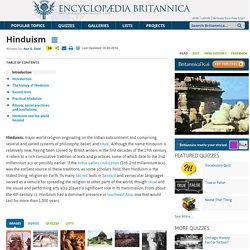
Although the name Hinduism is relatively new, having been coined by British writers in the first decades of the 19th century, it refers to a rich cumulative tradition of texts and practices, some of which date to the 2nd millennium bce or possibly earlier. If the Indus valley civilization (3rd–2nd millennium bce) was the earliest source of these traditions, as some scholars hold, then Hinduism is the oldest living religion on Earth. Its many sacred texts in Sanskrit and vernacular languages served as a vehicle for spreading the religion to other parts of the world, though ritual and the visual and performing arts also played a significant role in its transmission. From about the 4th century ce, Hinduism had a dominant presence in Southeast Asia, one that would last for more than 1,000 years. Introduction. Ancient India - Ancient Civilizations for Kids. 50 or 60 million years ago India slowly smashed into Asia and formed the Himalaya and Hindu Kush Mountains that nearly block off India from the surrounding area.
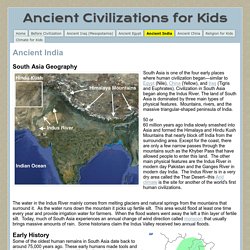
Except for the coast, there are only a few narrow passes through the mountains such as the Khyber Pass that have allowed people to enter this land. The other main physical features are the Indus River in modern day Pakistan and the Ganges River in modern day India. The Indus River is in a very dry area called the Thar Desert--this Arid climate is the site for another of the world's first human civilizations. The archeologist have found the remains of cities to be incredibly well planned out. Historians estimate that each major city could support as many as 80,000 people, so Ancient India was by far the largest early civilization. Farmers domesticated several plants including melons, wheat, peas, dates, sesame seeds, and cotton, as well as many animals.
Civilizations of India. India. India is a country in South Asia whose name comes from the Indus River.
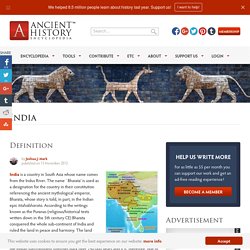
The name `Bharata’ is used as a designation for the country in their constitution referencing the ancient mythological emperor, Bharata, whose story is told, in part, in the Indian epic Mahabharata. According to the writings known as the Puranas (religious/historical texts written down in the 5th century CE) Bharata conquered the whole sub-continent of India and ruled the land in peace and harmony. The land was, therefore, known as Bharatavarsha (`the sub-continent of Bharata’).
Homonid activity in the Indian sub-continent stretches back over 250,000 years and it is, therefore, one of the oldest inhabited regions on the planet. Archaeological excavations have discovered artifacts used by early humans, including stone tools, which suggest an extremely early date for human habitation and technology in the area. Pre-History of India Mohenjo-Daro and Harappan Civilization.
Ancient India - The British Museum. The Ancient Indus Valley Civilization. BBC Bitesize - KS2 History - Indus Valley. Encyclopedia Britannica. The Olmec City of San Lorenzo. The Olmec City of San Lorenzo: The Olmec culture thrived along Mexico’s gulf coast from roughly 1200 B.C. to 400 B.C.
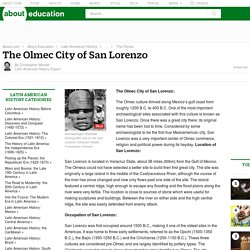
One of the most important archaeological sites associated with this culture is known as San Lorenzo. Once there was a great city there: its original name has been lost to time. Considered by some archaeologists to be the first true Mesoamerican city, San Lorenzo was a very important center of Olmec commerce, religion and political power during its heyday. Location of San Lorenzo: San Lorenzo is located in Veracruz State, about 38 miles (60km) from the Gulf of Mexico. 10 Facts About the Ancient Olmec in Mesoamerica. 9.
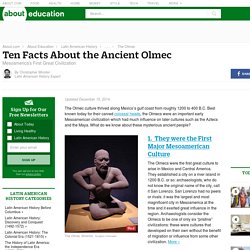
They were extremely influential The Olmec are considered by historians to be the "mother" culture of Mesoamerica. All later cultures, such as the Veracruz, Maya, Toltec and Aztecs all borrowed from the Olmec. History and Details on Olmec Art and Sculpture. Olmec Art and Sculpture: The Olmec culture was the first great Mesoamerican civilization, developing along Mexico's gulf coast from about 1200-400 B.C. before going into a mysterious decline.
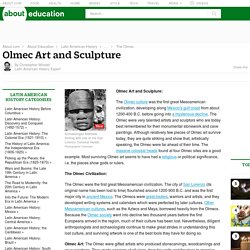
The Olmec were very talented artists and sculptors who are today best remembered for their monumental stonework and cave paintings. Although relatively few pieces of Olmec art survive today, they are quite striking and show that, artistically speaking, the Olmec were far ahead of their time. The massive colossal heads found at four Olmec sites are a good example. Most surviving Olmec art seems to have had a religious or political significance, i.e. the pieces show gods or rulers.
The Gods of the Olmec. The Gods of the Olmec The mysterious Olmec Civilization flourished between roughly 1200 and 400 B.C. on Mexico's gulf coast.

Although there are still more mysteries than answers about this ancient culture, modern researchers have determined that religion was of great importance to the Olmec. Several supernatural beings appear and re-appear in the few examples of Olmec art that survive today. This has led archaeologists and ethnographers to tentatively identify a handful of Olmec gods. Olmec Religion - the First Mesoamerican Civilization. Olmec Religion The Olmec civilization (1200-400 B.C.) was the first major Mesoamerican culture and laid the foundation for several later civilizations.

Many aspects of Olmec culture remain a mystery, which is not surprising considering how long ago their society went into decline. Nevertheless, archaeologists have been able to make surprising progress in learning about the religion of the ancient Olmec people. The Olmec Culture The Olmec culture lasted roughly from 1200 B.C. to 400 B.C. and flourished along Mexico's Gulf coast. Ancient Olmec Culture in Latin American History. Olmec Culture: The Olmec culture thrived along Mexico’s Gulf Coast from approximately 1200-400 B.C.

The first great Mesoamerican culture, it had been in decline for centuries before the arrival of the first Europeans, so much information about the Olmecs has been lost. We know the Olmecs primarily through their art, sculpture and architecture. Although many mysteries remain, ongoing work by archaeologists, anthropologists and other researchers has given us something of a glimpse into what Olmec life might have been like. Ancient Olmec Trade and Economy. Ancient Olmec Trade and Economy: The Olmec culture thrived in the humid lowlands of Mexico's gulf coast from about 1200-400 B.C.
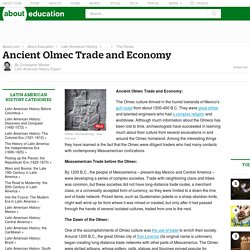
They were great artists and talented engineers who had a complex religion and worldview. Although much information about the Olmecs has been lost to time, archaeologists have succeeded in learning much about their culture from several excavations in and around the Olmec homeland. Among the interesting things they have learned is the fact that the Olmec were diligent traders who had many contacts with contemporary Mesoamerican civilizations. The Olmec: Precusors to Mesoamerican History. The Olmec, which translated via the Aztecs, means “rubber people”, were the inspiration behind the other four great main Mesoamerican civilizations namely the Toltec, the Aztecs, the Maya and the Inca, with a decided leaning toward the Maya, who may have been an outgrowth of the Olmec for reasons s we shall explore. We explore them simply because of their profound influence on everything that followed. They were a Pre-Columbian civilization living in the tropical lowlands of south-central Mexico, near the modern-day cities of Veracruz and Tabasco close to the coast before it turns east in the Yucatan peninsula.
The Olmec flourished during Mesoamerica's formative period, dating approximately from as early as 1500 BCE to about 400 BCE. They were the first great Mesoamerican civilization and laid many of the foundations for all the Central and South American civilizations that followed. We propose a hypothesis insofar that the Olmec were at least in part, immigrants from Africa. The Decipherment of the Olmec Writing System.
Oldest Writing in New World Discovered, Scientists Say. September 14, 2006 A writing system lost for 3,000 years has been rediscovered on an ancient stone tablet in Mexico, archaeologists say (map of Mexico). The New York Times > Science > Mother Culture, or Only a Sister? Published: March 15, 2005 n a coastal flood plain etched by rivers flowing through swamps and alongside fields of maize and beans, the people archaeologists call the Olmecs lived in a society of emergent complexity. It was more than 3,000 years ago along the Gulf of Mexico around Veracruz. The Olmecs, mobilized by ambitious rulers and fortified by a pantheon of gods, moved a veritable mountain of earth to create a plateau above the plain, and there planted a city, the ruins of which are known today as San Lorenzo.
They left behind palace remnants, distinctive pottery and art with anthropomorphic jaguar motifs. Most impressive were Olmec sculptures: colossal stone heads with thick lips and staring eyes that are assumed to be monuments to revered rulers. Olmec Civilization - Timeline and Definition. Olmec: An Introduction The Olmec civilization is the name given to a sophisticated central American culture with its heyday between 1200 and 400 BC. The Olmec heartland lies in the Mexican states of Veracruz and Tabasco, at the narrow part of Mexico west of the Yucatan peninsula and east of Oaxaca. Olmec Indians. Olmec Indians, an ancient Indian people of Mexico. They created the first civilization in North America.
It was centered in the tropical jungles of the Gulf Coast region near what is now Veracruz, and it flourished from about the 13th century B.C. to about the 1st century B.C. The Olmecs influenced the development of such later Indian cultures as the Mayan and the Zapotec. The three main centers of Olmec civilization were at San Lorenzo, La Venta, and Tres Zapotes, each of which contains remains of many large structures. The best-known Olmec artifacts are colossal stone heads, ranging in height from 5 to 10 feet (1.5–3 m). The first Olmec stone head was discovered in 1862, but it was not realized that it represented evidence of an early civilization until archeologists uncovered important Olmec sites during the 1920's. San Lorenzo - Olmec Civilization in Veracruz. The Enigma of the Olmecs - Softpedia.
The Olmec Civilization and the Use of Bitumen. Olmec Facts, information, pictures. Cacao use and the San Lorenzo Olmec. In 1996, Sophie Coe and Michael Coe argued in their book The True History of Chocolate that cacao, specifically a chocolate beverage, originated with the Olmec. They proposed that cacao, originally pronounced “kakawa,” was a vocabulary term used by the ancient Olmec as early as 1000 BCE. Ancient Society Research Resources. US National Archives. TeacherTube. YouTube Teachers. TED-Ed. Religion, World Religions, Comparative Religion - Just the facts on the world's religions. THEOI GREEK MYTHOLOGY, Exploring Mythology & the Greek Gods in Classical Literature & Art.
Mount Olympus. Mount Olympus. Olympus' highest peak, Mytikas Every year thousands of people visit Olympus to admire its nature, to tour its slopes, and reach its peaks. Family tree of the Greek gods. Key: The essential Olympians' names are given in bold font. See also List of Greek mythological figures Notes External links. Pan (god) Odyssey. Greek text of the Odyssey's opening passage The Odyssey (Greek: Ὀδύσσεια, Odýsseia) is one of two major ancient Greek epic poems attributed to Homer. American Museum of Science & Energy » Blog Archive » Cuban Missile Crisis: When the Cold War Got Hot. June 8, 2012 – September 3, 2012. Origins of The Cold War: 1946-1950. The Library of Congress' Photostream on Flickr. Primary Source Sets. National Jukebox LOC.gov.